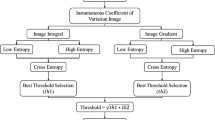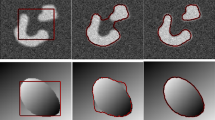Abstract
The manuscript describes an ultrasound image segmentation technique based on the fractional Brownian motion (FBM) model. Here, the ultrasound images are first enhanced using a fuzzy-based technique, and later the FBM model is employed to obtain the fractal features used for segmentation. The novelty lies in combining the fuzzy-enhancement technique and FBM model, and further illustrating that fractal length-based segmentation provides better results than fractal dimension-based segmentation. Experimental results on ultrasound images of carotid artery clearly illustrate that the segmentation outputs obtained from fractal length are superior, and the high qualitative values of DSC, Precision, Recall and F1 score (0.9617, 0.9629, 0.9653 and 0.9641 respectively), together with a low value of APD (1.9316), indicate that the proposed method is comparable to other state-of-the-art segmentation techniques.

Summary of proposed technique — overall design flow.









Similar content being viewed by others
References
Jiang M, Zhang S, Li H, Metaxas D (2015) Computer-aided diagnosis of mammographic masses using scalable image retrieval. IEEE Trans Biomed Eng 62(2):783–792
Moon WK, Shen YW, Huang CS, Chiang LR, Chang RF (2011) Computer-aided diagnosis for the classification of breast masses in automated whole breast ultrasound images. Ultrasound Med Biol 37(4):539–548
Han SM, Lee HJ, Jin YC (2008) Computer-aided prostate cancer detection using texture features and clinical features in ultrasound image. J Digit Imaging 21(1):121–133
Shanmugam N, Suryanarayana AB, Tsb S, Chandrashekar D, Manjunath CN (2011) A novel approach to medical image segmentation. J Comput Sci 7(5):657–663
Moursi SG, Sakka MRE (2009) Semi-automatic snake based segmentation of carotid artery ultrasound images. Commun Arab Comput Soc (ACS) 2(2):1–32
Hossain MM, AlMuhanna K, Zhao L, Lal B, Sikdar S (2015) Semiautomatic segmentation of atherosclerotic carotid artery lumen using 3d ultrasound imaging. Med Phys 42(4):2029–2043
Loizou CP, Nicolaides A, Kyriacou E, Georghiou N, Griffin M, Pattichis CS (2015) A comparison of ultrasound intima-media thickness measurements of the left and right common carotid artery. IEEE J Translat Eng Health Med 3:1–10
Loizou CP, Pattichis CS, Pantziaris M, Tyllis T, Nicolaides A (2007) Snakes-based segmentation of the common carotid artery intima media. Med Biol Eng Comput 45(1):35–49
Loizou CP, Petroudi S, Pantziaris M, Nicolaides AN, Pattichis CS (2014) An integrated system for the segmentation of atherosclerotic carotid plaque ultrasound video. IEEE Trans Ultrason Ferroelectr Freq Control 61(1):86–101
Molinari F, Meiburger KM, Saba L, Acharya UR, Ledda M, Nicolaides A, Suri JS (2012) Constrained snake vs. conventional snake for carotid ultrasound automated IMT measurements on multi-center data sets. Ultrasonics 52(7):949–961
Sifakis EG, Golemati S (2014) Robust carotid artery recognition in longitudinal B-mode ultrasound images. IEEE Trans Image Process 23(9):3762–3772
Meiburger KM, Acharya UR, Molinari F (2018) Automated localization and segmentation techniques for B-mode ultrasound images: a review. Comput Biol Med 92:210–235
Qian C, Yang X (2018) An integrated method for atherosclerotic carotid plaque segmentation in ultrasound image. Comput Methods Programs Biomed 153:19–32
Omiotek Z (2017) Fractal analysis of the grey and binary images in diagnosis of Hashimoto’s thyroiditis. Biocybernet Biomed Eng 37(4):655–665
Wang X, Jiang A, Wang Y (2011) A segmentation method of smoke in forest-fire image based on fbm and region growing. In: Proceedings of Chaos–Fractals Theories and Applications (IWCFTA) 2011: IEEE Fourth International Workshop in Hong Kong, China (pp. 390–393)
Lin PL, Huang PW, Lee CH, Wu MT (2013) Automatic classification for solitary pulmonary nodule in CT image by fractal analysis based on fractional Brownian motion model. Pattern Recogn 46(12):3279–3287
Lin PL, Huang PW, Huang PY, Hsu HC (2015) Alveolar bone-loss area localization in periodontitis radiographs based on threshold segmentation with a hybrid feature fused of intensity and the H-value of fractional Brownian motion model. Comput Methods Prog Biomed 121(3):117–126
Hasikin K, Isa NAM (2013) Fuzzy image enhancement for low contrast and non-uniform illumination images. In: Proceedings of Signal and Image Processing Applications (ICSIPA) 2013: IEEE International Conference, Melaka, Malaysia (pp. 275–280)
Wang Y, Li D, Xu Y (2013) An improved image enhancement algorithm based on fuzzy sets. In: Conference Anthology, China, IEEE (pp. 1–4)
Hasikin K, Isa NAM (2012) Enhancement of the low contrast image using fuzzy set theory. In: Proceedings of UKSim, International Conference on Computer Modelling and Simulation, United Kingdom (pp. 371-376)
Binaee K, Hasanzadeh RP (2014) An ultrasound image enhancement method using local gradient based fuzzy similarity. Biomed Signal Process Contrl 13:89–101
Lopes R, Betrouni N (2009) Fractal and multifractal analysis: a review. Med Image Anal 13(4):634–649
Bojdecki T, Gorostiza LG, Talarczyk A (2004) Sub-fractional Brownian motion and its relation to occupation times. Stat Proba Lett 69(4):405–419
Lundahl T, Ohley WJ, Kay SM, Siffert R (1986) Fractional Brownian motion: a maximum likelihood estimator and its application to image texture. IEEE Trans Med Imaging 5(3):152–161
Boufoussi B, Hajji S (2012) Neutral stochastic functional differential equations driven by a fractional Brownian motion in a Hilbert space. Stat Proba Lett 82(8):1549–1558
Zachevsky I, Zeevi YY (2014) Single-image superresolution of natural stochastic textures based on fractional Brownian motion. IEEE Trans Image Process 23(5):2096–2108
Li BN, Chui CK, Chang S, Ong SH (2011) Integrating spatial fuzzy clustering with level set methods for automated medical image segmentation. Comput Biol Med 41(1):1–10
Li C, Gore JC, Davatzikos C (2014) Multiplicative intrinsic component optimization (MICO) for MRI bias field estimation and tissue segmentation. Magn Reson Imaging 32(7):913–923
Abdelsamea MM, Gnecco G, Gaber MM (2017) A SOM-based Chan–Vese model for unsupervised image segmentation. Soft Comput 21(8):2047–2067
Ramamurthy B, Chandran KR (2012) Content based medical image retrieval with texture content using gray level co-occurrence matrix and k-means clustering algorithms. J Comput Sci 8(7):1070–1076
Gottron, T. (2008). Content code blurring: a new approach to content extraction. In: DEXA ‘08 Proceedings of the 2008 19th International Conference on Database and Expert Systems Application, Turin, Italy (pp. 29–33). IEEE
Ostry DJ, Darainy M, Mattar AA, Wong J, Gribble PL (2010) Somatosensory plasticity and motor learning. J Neurosci 30(15):5384–5393
Acknowledgements
This research was financially supported by the Foundation of China (No.61471228), the Key Project of Guangdong Province Science & Technology Plan (No. 2015B020233018), and the Scientific Research Grant of Shantou University, China, Grant No: NTF17016.
Author information
Authors and Affiliations
Corresponding author
Rights and permissions
About this article
Cite this article
Zhuang, Z., Lei, N., Joseph Raj, A.N. et al. Application of fractal theory and fuzzy enhancement in ultrasound image segmentation. Med Biol Eng Comput 57, 623–632 (2019). https://doi.org/10.1007/s11517-018-1907-z
Received:
Accepted:
Published:
Issue Date:
DOI: https://doi.org/10.1007/s11517-018-1907-z




